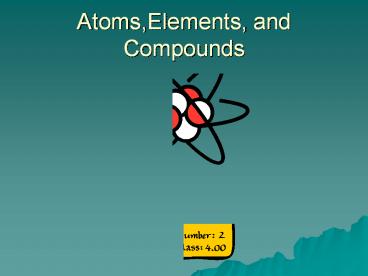Atoms,Elements, and Compounds - PowerPoint PPT Presentation
1 / 19
Title:
Atoms,Elements, and Compounds
Description:
A desk, the air, even you are made up of atoms! Matter ... Parts of the Atom. Electron = negative particle circling the nucleus (each electron has a 1 charge) ... – PowerPoint PPT presentation
Number of Views:3182
Avg rating:3.0/5.0
Title: Atoms,Elements, and Compounds
1
Atoms,Elements, and Compounds
2
ATOMS
- Atoms are the basic building blocks of matter
that make up everyday objects. - A desk, the air, even you are made up of atoms!
- Matter- Anything that takes up space
3
Parts of the Atom
- Electron negative particle circling the
nucleus (each electron has a 1 charge) - Proton positive particle found in the
nucleus (each proton has a 1 charge - Neutron neutral particle found in the nucleus
(a neutron has no charge)
4
Atomic Number
- The number of protons in an atom defines what
element it is. - For example carbon atoms have six protons,
hydrogen atoms have one, and oxygen atoms have
eight. - The number of protons in an atom also determines
the chemical behavior of the element.
5
Carbon and the periodic table
- Carbon
- Atomic symbol C
- Atomic number 6
- Atomic Mass 12
- Atomic protons
- protonselectrons
- Atomic Weight weight of protons, neutrons, and
electrons - Electrons add little weight and are insignificant
on a periodical table - Protons and Neutrons weigh the same
Neutrons Atomic Weight (rounded) Atomic
number
6
ELEMENTS
- substances that cannot be decomposed or broken
into simpler substances by ordinary chemical
means. - Elements are made up of only one kind of atom
ex. Carbon(C), oxygen(O2), helium(He)
7
Element Name and Symbol
- Atomic SymbolThe atomic symbol is one or two
letters chosen to represent an element ("H" for
"hydrogen," etc.). - Memorize the symbols/ names of the following
- C Carbon
- O Oxygen
- H Hydrogen
- He Helium
- Na Sodium
- Fe Iron
- N Nitrogen
- S Sulfur
8
Compounds
- Substance formed by a combination of two or more
elements - (ex. Water (H2O) has hydrogen and oxygen
9
Mixtures/Solutions
- Mixture- Substances that do not dissolve together
but mix - Solutions Mixture that is evenly distributed
throughout the solution
Solution
10
Mixtures
- Solution
- Solute- NaCl
- Solvent- water
NaCl Dissolving in Water When an ionic compound
such as sodium chloride is placed in water, water
molecules surround and separate the positive and
negative ions.
11
Mixtures
- Mixture
- Different particles not dissolved
12
Atom vs. Molecule
- Atom the smallest possible particle of a
molecule that retains its chemical properties - Molecule - two or more atoms in a definite
arrangement held together by chemical bonds
Example A Hydrogen Atom
Water is always H2O
13
What is in a Molecule
- Formulas
- Subscript (Little number after an element symbol
in a molecule) means there are that number of the
previous Atom - H2O Water
- 2 Hydrogen 1 Oxygen
- Ammonia NH3
- 1 Nitrogen 3 Hydrogen
- Sucrose C12H22O11
- Table Salt NaCl
- Sodium Bicarbonate NaHCO3
H2O
14
Definitions
Bond - joins two atoms togetherThe Octet Rule-
Says that atoms tend to gain, lose or share
electrons so as to have eight electrons in their
outer electron shell. -To be stable atoms must
have their outer orbit filled. -Usually the
outer orbit holds 8 electrons -Hydrogen and
Helium have an outer orbit that only holds 2
electrons. Chemical bond a force that holds
two atoms together (occurs because atoms want to
achieve stability ) atoms want to have a complete
outermost energy level
15
Types of bonds
- Ionic bonding bonding that involves a transfer
of electrons (one atom gains electrons and one
atom loses electrons) ions are formed - Electrons have a -1 charge
- A positive ion is formed when a electron is given
off - A negative ion is formed when a electron is
gained
16
Types of Bonds
- Covalent bonding - occurs when atoms share
electrons to fill outer orbits. Water is 2
Hydrogen and 1 Oxygen covalently bonded.
17
Covalent bonding
- Electrons in a covalently bonded compound are not
shared equally - Larger atoms tend to hog more electrons.
- In water Oxygen hogs
- more of the electrons and
- therefore the oxygen side
- is more negative and the
- hydrogen side is slightly
- positive
- -When there are different
- charged sides the molecule
- is said to be polar.
- side
side
18
Hydrogen Bonds
- Attraction that forms between two polar molecules
(when hydrogen is present). - The positive side of one polar molecule attracts
and is bonded to the negative side of another
polar molecule.
19
Compound
- A substance formed by the combination of two or
more elements in definite proportions. - Exp NaCl, Salt































